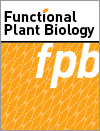
Functional Plant Biology
Volume 48 Number 4 2021
MiR397 is involved in regulation of plant development under various conditions. This review provides concise and precise updates on the latest progress on the research of a conserved microRNA, miR397. It will be helpful in understanding the function of miR397 and divulging its application prospects for increasing agricultural production as well as its ability to enhance plant adaptation to abiotic stresses.
FP20342 Abstract | FP20342 Full Text | FP20342PDF (315 KB) Open Access Article
The present work primarily emphasises on management of continuously increasing ozone (O3) stress on an economically important legume, Cymopsis tetragonolobaI L. Taub. Our experiment showed that soil nitrogen amendments can be effectively used to partially manage O3 injury by either strengthening the defence system or by regulating the stomatal movement to minimise O3 entry into plants. The results have established an O3–N dose relationship, which can be further studied upon and has helped in screening varieties that are more responsive to soil nitrogen amendments.
Late embryogenesis-abundant (LEA) proteins play a vital role in regulating plant growth and development as well as a variety of stress responses. This study is the first to report the characteristics of the LEA gene family in Brachypodium distachyon L. It provides valuable information for understanding the evolution of LEA in the model plant B. distachyon and for functional research on these proteins.
FP20185ZxNHX1 indirectly participates in controlling K+ homeostasis in the xerophyte Zygophyllum xanthoxylum
In Zygophyllum xanthoxylum, a xerophytic shrub, the silencing of ZxNHX1 (tonoplast Na+/H+ antiporter) triggered the reduction of Na+ and K+ concentration under 50 mM NaCl treatment. In this work, the K+ concentration displayed no significant variation in ZxNHX1-RNAi lines compared with the wild type under osmotic stress, indicating that ZxNHX1 might not directly participate in controlling K+ homeostasis. The results provide a basis for further researches on the transport of Na+ and K+ in Z. xanthoxylum.
FP20200Root length is proxy for high-throughput screening of waterlogging tolerance in Urochloa spp. grasses
 , Juan A. Cardoso, Lukasz Kotula, Erik J. Veneklaas, Ole Pedersen and Timothy D. Colmer
, Juan A. Cardoso, Lukasz Kotula, Erik J. Veneklaas, Ole Pedersen and Timothy D. Colmer
Urochloa spp. grasses are the most widely planted forages in the tropics. Forage production is highly restricted by transient or seasonal waterlogging. We evaluated the responses of eight Urochloa cultivars to waterlogging conditions. We found that traits improving internal aeration in roots are conferring waterlogging adaptation in these important grasses. Plants with larger roots had better abilities for internal aeration and greater waterlogging tolerance. This roots characteristic can potentially be used for selecting and developing cultivars with outstanding waterlogging tolerance.
Although recent studies have proposed that high predawn stomatal conductance may enhance photosynthesis and growth of plants, the causality of this linkage is disputable. Our results suggest that night-time processes strongly depend on previous day light availability and the relationship between night-time stomatal conductance and tree growth characteristics are not directly related to predawn stomatal opening. Our findings indicate that daily CO2 assimilation probably provides feedback for stomatal opening before dawn.
FP20181Genetic factors associated with favourable pollinator traits in the wheat cultivar Piko
Hybrid wheat breeding has a great potential to increase yield and a good pollinator is essential for efficient hybrid seed production. Piko, a winter wheat cultivar, is one of the best pollinator among limited resources. However, the genetic factors responsible for Piko’s favourable traits are largely unknown. Our study identified genetic factors associated with multiple traits including anther extrusion, anther length and spike architecture. These genetic factors could potentially be used to improve hybrid seed production by breeding elite pollinators.
FP20287A redundant hydraulic function of root hairs in barley plants grown in hydroponics
The study makes use of the brb-barley root hair mutant of Hordeum vulgare L. and shows that root hairs can have a redundant hydraulic function, both for plants grown under nutrient sufficient conditions and for plants subjected to a low supply with N and P, in a hydroponics setup. The study highlights differences in the formation of apoplastic barriers between the brb mutant (less) and its parent wild-type cv. Pallas (more barriers). These differences may provide the brb mutant with some hydraulic compensatory mechanisms.




